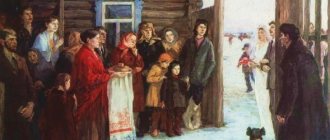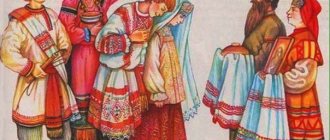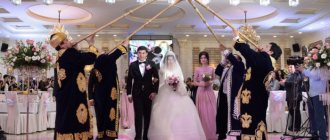An Indian wedding is an incredible combination of pomp and brightness of celebration and amazing tradition. The customs that still play an important role in the lives of Hindus may seem strange and inexplicable. However, it is this unquestioning belief in the power of tradition and unwavering adherence to centuries-old rules of marriage that make weddings in India, like Turkish weddings, a real cultural phenomenon: once you have attended such a celebration, you will never forget it. An Indian wedding is thoroughly imbued with unusual traditions and customs, from the preparation and conduct of the celebration itself to the national costumes of the newlyweds with their brightness and pomp.
On the portal svadebka.ws you will learn many amazing facts about weddings in India, as well as the traditions and customs that newlyweds religiously follow in order to create a truly strong union.
Top 5 interesting facts related to Indian wedding
A wedding in India is a unique celebration, filled with many interesting moments that can amaze and surprise. Here are some of them:
- The bride does not participate in any way in choosing the groom (as in the case of Muslim weddings). Her parents do this for her. Moreover, they choose mainly according to the horoscope - if the star destinies of the newlyweds coincide, then there will be a wedding.
- A wedding in India is paid for by the bride's side. Moreover, a lot of money is spent on such a celebration. The groom's side only presents expensive gifts to the bride.
- Indian weddings usually amaze with the number of guests - up to 700 people can be invited to the celebration.
- During the period from engagement to wedding, the families of the bride and groom are prohibited from eating meat, only dairy and vegetable dishes. And on the wedding day, before the ceremony begins, the bride and groom have no right to eat anything at all.
- Henna designs on the bride's hands should not be washed off during homework. Therefore, for about a month after the wedding, the young woman rests and enjoys her new status. Great tradition, isn't it?!
LiveInternetLiveInternet
Quote from Antonina_Nikolaevna's message
Read in full In your quotation book or community!
Read on the topic: Indian women's jewelry * Wedding. Indian style. * Indian wedding traditions * SARI is the national dress of India. * Shalwar kameez is the national dress of India * Men's clothing of India
Wedding rituals in India
are distinctly traditional - this means that they have remained almost the same as they were thousands of years ago. I will immediately emphasize the essential ways in which Indian marriage differs from all others. In other countries, a boy usually chooses a girl, but the opposite situation often occurs. In India, marriage depends entirely on the decision of the groom's parents. They look for a suitable bride for their son and negotiate with her parents about a future marriage. Little depends on the girl: in the end, her parents can simply order her to marry even an unfamiliar young man, and she is obliged to obey. This is why the Indian matrimonial system is called “arranged marriage”.
After an agreement between the parents, two meetings of the future unit of society are organized, which is called “ashir-vad” or “blessing”. The first meeting takes place in the bride's house, the second in the groom's house. During these meetings, the newlyweds receive gifts from future relatives and give gifts to each other.
Of course, times are changing, and more and more marriages in India are for love, but only residents of large cities are so advanced in these matters, while the rest of India lives the old fashioned way.
The happiness of young people is also greatly influenced by their belonging to one caste or another. Let me remind you that in India there were 4 main castes - Brahmins (priests), Kshatriyas (warriors), Vaishyas (traders, cattle breeders and farmers) and Shudras (servants and laborers). Naturally, marriage can only be concluded among families in one’s own caste. If a young man’s family married him to a girl from a lower caste, then the family’s prestige was reduced to that of the bride’s family. In modern India, the caste system has officially been abolished, but in reality this is not the case. Belonging to one caste or another is easy to determine (easy, of course, for an Indian, not for us).
But, there is some progress... you can even find such advertisements in newspapers, in the dating section: “A professional educated man 79/5'7″CA/CPA/MBA, working in the USA, is looking for an educated girl. Caste is not important."
But, along with such bold statements, there are also these:
“a 30-year-old Sikh in a turban (!), who has a separate house and an income of 50,000 rupees.”
On the wedding day, the bride and groom are not allowed to eat anything until the wedding ceremony begins. In the groom's house, girls from among the relatives perform wedding dances and songs. Then a small but important ritual is performed called “gaye kholud” - a ritual in praise of the color yellow, which Indians associate with the color of the sun and serves as a symbol of fidelity. The Gaye Kholud ceremony is very reminiscent of the festival of colors, Holi, with the only difference being that there is only one color - yellow. First, everyone present paints their foreheads, and then sprinkles yellow powder on each other.
After “gaye kholud,” the groom’s father, in a solemn voice, lists the names of the deceased relatives of this family, as if calling them as witnesses and informing the spirits of the ancestors that their descendant is getting married. Then all participants in the ceremony go to the bride’s house, where the Gaye Kholud ceremony is repeated.
Bride and Groom Suits
Traditional Indian wedding dresses are the most exquisite and colorful wedding dresses in the whole world. The red color of the dress is generally accepted in all regions of India, however, modern fashionistas have begun to use other colors. Indian wedding dresses are very different from traditional Western dresses. The bride should literally sparkle on her wedding day - this is exactly the effect that they try to achieve with rich embroidery, decorations and the use of reflective fabrics for the dress - satin, silk or chiffon.
India is a large country and the style of a wedding dress varies slightly from region to region, but the types of wedding attire remain unchanged: • sari - traditional Indian clothing - a piece of long fabric wrapped in a special way around the body. • ghagra choli is a traditional North Indian outfit consisting of a floor-length skirt (lahenga), a blouse with short/long sleeves and a long scarf thrown over the shoulder. • salwar (shalwar) kameez - appeared in India during the Mongol conquests, but, unlike the Mongols, remained forever. These are extremely comfortable clothes “for every day”, consisting of trousers and a long blouse.
Why red and shades of red? Red is the color of good luck and will bring a lot of happiness to the future family.
The bride and groom, personifying beauty and elegance, are dressed in luxurious clothes so that the eyes of the guests are fixed on the happy couple. The 16 mandatory elements of a bride's wedding wardrobe, called Solah Shringar are:
Wedding outfit . Traditionally, the bride's wedding attire is a sari, lenga choli (lehenga) or salwar kameez. However, the wedding attire may correspond to the clothing worn in a particular region of India. The classical Indian wedding dress of the bride, in accordance with Vedic prescriptions, should be red, although sometimes there are others, for example, purple, burgundy, orange, gold, and in Maharashtra - green. The wedding dress of the bride among the ancient Slavs was also red, and the ancient expression “red maiden,” which came to us from ancient times, means the following: innocent, pure, modest, beautiful, like a bride dressed in red.
Black and white colors are prohibited because... black is considered a symbol of ignorance, impurity, darkness, and white has been considered the color of widowhood and mourning among Indian women since Vedic times. By the way, it is worth noting that in ancient times, white was also considered a mourning color among all Indo-European peoples, for example, the Slavs. Black appeared with the advent of Christianity, which borrowed it, like the tradition of hanging mirrors in the house of the deceased, from Judaism. In the 16th century Queen Anne of England established the tradition of wearing black clothes as a sign of mourning. Since then, in many countries around the world, widows have worn black dresses.
Kesapasharacana . To create a magnificent wedding hairstyle (keshapasharachanu), you need to anoint the bride's hair with fragrant oils, decorate it with flower garlands and jewelry. A traditional wedding hairstyle is a braid decorated with flower garlands. Long hair braided is the most important detail of the appearance of an Indian woman, preserved since Vedic times. According to Vedic traditions, a pious woman should have long hair braided. A woman can unbraid her hair in the following cases: a) during periods of intimacy with her husband; b) when performing ablution. Loose hair is also allowed for girls who have not reached puberty. Appearing, as they say, “in public” in a public place with your hair down was considered the greatest sin and shame. Only hetaeras (courtesans), harlots and slaves were allowed to wear their hair down. The ancient Slavic (Old Russian) expressions “dissolute” and “slutty” indicate to us that in Rus' they once adhered to ancient Vedic traditions. Kajal or anjana - black eyeliner makes the bride's look attractive and mysterious.
Bindi is a red dot on the forehead that is a sacred symbol of a married woman. Sometimes the bindi is complemented with small white dots or delicate designs around the eyebrows.
Sindoor is the bride's parting, dyed red during the wedding ceremony.
Mangtika is a parting of jewelry.
Nath is a nose ring worn in the left nostril. Like the bindi and sindoor, it (worn in the left nostril) is a symbol of a married woman.
Karn Phool are unusually beautiful wedding earrings, usually inlaid with precious stones in abundance, which is why they are quite heavy.
A haar is a wedding necklace, traditionally made of gold and studded with precious stones, and has different variations depending on the region. In many families, haar is passed down through generations.
Bajubankh (baajuband) are bracelets that are worn on the hands above the elbow.
Mehndi is a design made with henna on the hands and feet.
Chudiyan are bracelets worn on the wrist, usually red in color.
Itar - aromatic oils.
Kamarband (kamerband) is an elegant gold or silver belt inlaid with stones, which is worn on the lower back to support a wedding dress.
Payal - silver anklets with many small bells that make a gentle melodious ringing in time with their gait.
Aarsi is a large, elegant mirror ring worn on the thumb.
In addition to the dress, there are mandatory jewelry that complete the image of the bride and carry additional symbolism - these are necklaces, glass bracelets on both hands, silver anklets, rings on both hands, toe rings, earrings, a nose earring with a chain to ear and special hair decorations - there is never a lot of jewelry in India. Such abundance is the norm for the Indian bride, who, as I have already said, should shine in the truest sense of the word. Whatever it is, both the bride and groom are generously sprinkled with garlands of flowers from above. There is another decoration, the mangal-sutra (thali necklace), which the groom ties around the bride’s neck during the ceremony - this decoration symbolizes that the man places himself under the magical protection of the woman (after all, it is the woman who is able to provide prosperity and good luck to her husband). The necklace consists of black beads or beads and a gold insert.
An integral part of the bride’s decoration is also mehndi (mehendi) - a short-term henna tattoo. These tattoos are applied to the bride, her friends and female relatives during the pre-wedding celebrations. Mehndi in India is applied only during major celebrations - Diwali (festival of Lights), weddings, engagements.
Mehndi or henna comes in various shades and colors ranging from reddish and orange to brown and black. Other colors are also available by mixing the dyes and adding them to the henna. The more refined and intricate the mehndi pattern, the happier the future life of the young family will be. Most often, symbols of fertility and religious motifs are interspersed into the patterns, and you can also encrypt the name of your lover.
The groom's wedding attire, like the bride's attire, is beautiful and elegant. Traditionally, it consists of a sherwani (a long frock coat buttoned up to the collar) of various colors, decorated with gold thread embroidery, and churidars (tight trousers). In addition to the costume, traditional beaded shoes with turned-up toes called juti are worn, as well as a magnificent turban called pagdi (pagri) or safa. In Punjab, the groom's face is covered with pendants made of beads or flowers, called sehra. Dressed in rich wedding clothes, the bride and groom, like god and goddess, dazzle with their beauty.
Most people in India share the beliefs of Hinduism and practice traditional rituals that have existed since the birth of the religion. One such ritual is the wedding ceremony. Indian weddings are well-thought-out, elegant celebrations that last from three days to several weeks (depending on the wealth of the families and the talent of the Brahman - the leader of the ceremony). Moreover, certain rituals are performed every day, varying somewhat from region to region and containing from eight to eighteen basic steps. Modern, rapidly developing India, unfortunately, no longer has enough time to follow all the numerous wedding traditions, but all the most important things, nevertheless, remain unchanged. First of all, this concerns the wedding decoration, because the wedding decorations should match the brilliant bride and groom. Traditional Indian wedding colors are red and gold. Red, as I already mentioned, brings good luck, and gold or yellow is a symbol of the sun and fidelity.
The most commonly used flowers for decoration are orchids, carnations, small roses, lilies - all this is woven into garlands. Moreover, the norm is to use artificial and fresh flowers together. Carpets, tapestries, candles and incense are used in decoration along with flowers. Usually no less money is spent on decorating the place of celebration than on the clothes of the newlyweds themselves and their close relatives, since a wedding is also a public unification of two families.
The wedding day and pre-wedding festivities vary from state to state, so the list below is just one of the many options for celebrations in India.
Before the
Sagaai (engagement)
Sagaai - betrothal ceremony: the bride comes to the groom's house with a special offering - matli, which brings good luck.
Usually this is some kind of box with sweets and gifts for the groom and his family. This ritual symbolizes the bride's family's acceptance of the union of their daughter and her future husband. A small ceremony then takes place where five women from each family bless the future couple. Garba (pre-ceremony party, bachelor party)
Garba is a dance party held on the eve of the ceremony. Garba is an excellent opportunity for relatives of the future newlyweds to meet and have a good time on the eve of the ceremony.
Pithi (yellow color ceremony)
The color yellow in India symbolizes fidelity, and it would be ridiculous not to praise it before the ceremony... which is what is done in the home of the bride and groom, where their relatives and friends gather.
They apply yellow paint to the newlyweds' foreheads, thereby cleansing the newlyweds before the ceremony, and sprinkle yellow paint on each other. Mehndi (bride's decoration, bachelorette party)
The day before the ceremony, her close friends and family members gather at the bride's house, her legs and hands are painted with henna, after which she is dressed in a wedding dress while wedding songs and Vedas are sung.
Mandap Mahurat
This is a typical ritual carried out on the eve of any important event in the life of the family - the Pandit performs rituals in the house of the bride and groom, during which the families pray to Ganesh and seek his blessings.
Griha Shanti (Peace to Your Home!)
This is a ritual of studying the horoscopes of the future newlyweds and choosing the most favorable date and time for the ceremony. The ceremony is performed by the Pandit for the bride, her relatives and the groom's family members. Happiness and peace in the family depend on the choice of a favorable date.
The wedding itself is usually held in the evening - and always in the bride's house, where the groom arrives at the appointed hour, accompanied by relatives and friends.
At this point, a small temple has already been prepared, specially built for the ceremony. It is covered with an awning, decorated at the corners with four palm trees and decorated with many fragrant flowers, mostly yellow. The groom stands on a flat stone and waits for several people to carry out the bride in a wooden palanquin - in a rich, usually bright red sari, with a lot of jewelry. The porters walk around the groom seven times, and then, stopping, ask the newlyweds to look into each other's eyes. This look is called “shubho drishti” - the very first look. Ceremony Day
(Wedding Procession)
The groom arrives at the ceremony venue with his friends and family members. Many people use horses or special carts for transport. The arrival of the groom is accompanied by noisy celebrations and dancing. Traditionally, Gujartians choose their brides from other cities or villages, so on the day of the ceremony, the groom's wedding cortege arrives at the bride's village.
Ponkvu (Groom's arrival, ceremony begins)
The arrival of the groom is considered the official start of the ceremony.
The groom is greeted by his mother-in-law, attempting to perform the symbolic ritual of grabbing the groom's nose, which is meant to remind him that it was he who knocked on their door to ask for their daughter's hand in marriage. Jaimala (Exchange of Flower Garlands)
After the Ponkvu ceremony, the bride appears and she and the groom place flower garlands around each other's necks.
Traditionally, during this ceremony, the groom is located above the bride, usually the groom's friends take care of this, thereby showing that the bride cannot “take” the groom from her family and friends. Madhuparka (The bride's family receives the groom)
The mother-in-law brings the groom to the Mandap - a special canopy or tent for the newlyweds, where the most important ritual of the evening takes place. A traditional fire is lit in the mandapa and sacred prayers are said. The second no less important element of the wedding is the Shamiana - a cloth tent for guests, where they are treated to food while waiting for the bride and groom. In the mandap, the bride's brother washes the groom's feet, thereby "accepting" him into the family, while the bride's sister tries to "steal" his shoes. After all, according to tradition, the groom must leave his wedding in the same shoes in which he came to it, and if the shoes are “stolen,” they must be “ransomed” from his daughter-in-law.
Kanya Agamana (Bride's Entrance)
The bride is brought to the mandap by her maternal uncle.
Before the ceremony begins, a special curtain (antarpaat) is pulled between the bride and groom, separating them from each other. The guru begins the ceremony, the curtain comes down and the couple can exchange garlands. The ceremony takes place in front of the sacred fire. Kanya Daan (Bride Handover)
The ceremony of handing over the bride by her parents to the groom - the bride's hand is placed in the groom's hand.
The bride's parents do not eat anything before the ceremony, thereby purifying themselves. It is believed that at a wedding, parents hand over their daughter, Goddess Lakshmi, to the groom, God Vishnu. Hasta Milap (Union of Two Souls)
The groom's scarf is tied to the bride's sari to symbolize the union of two souls.
The Guru says prayers invoking Goddess Lakshmi and Goddess Parvati. The couple's relatives unite by sprinkling rice and petals on the newlyweds. Varmala
The bride and groom's necks are tied with a cord to protect them from evil.
This is done by the older relatives of the newlyweds. Mangal Pheras
The newlyweds walk around the sacred fire 4 times, symbolizing the basic human goals in life - Dharma (morality, righteousness), Artha (wealth, material wealth), Kama (joy, mental satisfaction) and Moksha (liberation, eternal bliss). At this time, the Guru says a prayer and the groom repeats after him. It’s funny that after 4 laps the young people are in a hurry to take their places, since there is such a sign that the one who sits down first will rule the house.
Saptapadi (Seven Ritual Steps)
The groom helps the bride take the seven ritual steps (touch the big toe of her right foot to the seven “steps”) while they say the seven vows. Each step is also accompanied by a prayer said by the groom. 1. With the first step, the couple asks the gods for a clean, comfortable and noble life. 2. With the second step, they pray for physical and mental health and ask for a healthy and peaceful life for themselves. 3. The third step is to ask for spiritual strength to fulfill spiritual obligations. 4. In the fourth step, they ask for happiness and harmony, which can be achieved through mutual love, trust and a long life together. 5. The fifth step is taken with a prayer for the well-being of all living relatives and for the birth of noble children. 6. The sixth step is a promise to be together and go through all the joys and hardships together. 7. During the last seventh step, they pray for life in general, asking for mutual understanding, respect, unity not only for themselves, but for the whole world.
Sindoor Daan
Next comes the Sindhur Daan ritual.
Sindhoor is a red powder that the groom uses to apply a stripe to the bride's parting. This red stripe in the hair, as well as the dot in the middle of the forehead, indicates the woman’s married status. Saubhagyavati Bhava
Seven married women from the bride's side pass by the couple and whisper blessings into the bride's right ear.
Ashirwaad
A wedding traditionally ends with the young family asking for blessings from their elders.
After the
Vidaai
The departure ceremony of a newly married couple is often accompanied by tears of joy and sadness.
Ghar Nu Laxmi
When the couple arrives at the groom's house, the bride is welcomed as Goddess Laxmi, bringing good luck to the new home.
The mother-in-law (mother of the groom) places a container of rice at the entrance to the house. If the bride spills rice by touching it with her right foot, then this is a sign of wealth. Thus, the bride accepts her responsibilities in her new home. Aeki Beki
A game where the idea is to find a ring that is placed in a tray with water, red powder, milk and a few coins. It is believed that whoever finds the ring four out of seven times will be the head of the house and will rule the household. The day ends with prayers asking for the happiness and love of the young.
The entire wedding procession then moves to the place where the priest, having said a prayer and heard the oath of the newlyweds, will connect the hands of the newlyweds with a garland of flowers. At this moment, the groom will apply red paint to the forehead and parting of his bride: now they are already husband and wife. Then everyone goes to celebrate in a room called “bozargan”, where a whole performance is staged with dances and songs. The fun lasts all night, and in the morning the guests leave the young wife’s house, taking her to her husband’s house, where gifts and blessings also await the newlyweds. There are no ceremonies on this day: everyone rests. And only the next day, at the husband’s house, the wife’s relatives are received with gifts, dinner and entertainment are arranged for them.
The groom is taken to the pandal and seated near a bowl of rice. The bride appears accompanied by her mother, relatives and friends. The groom gets up, to the sounds of the wedding melody, the bride slowly puts a flower garland around his neck and receives the same one from her future husband. Then the newlyweds exchange rings, and the groom gives the bride a gold chain, which she will now wear for the rest of her days.
Women in the south do not part their hair or mark their marriage mark on their foreheads. For them, a gold chain serves as such a sign. Taking it off is a bad omen.
In the evening, the newlyweds are taken to a room reserved for them, where the husband is given a glass of milk and left alone, while the young wife is taken to the guests. The festive dinner begins. after which all the guests from the groom’s side go home, and the bride returns to her husband’s room. The next morning he takes her on his honeymoon.
And now about the cheapest wedding in the world, which costs 1 rupee and 25 paise (about 16 kopecks). In the very north of the country lives the Nandhari tribe. Weddings here are celebrated extremely simply, even ascetically. Dowry, gifts, any demonstration of wealth, boasting of wealth are strictly prohibited. There are no single Nandhari weddings. Several times a year, collective celebrations are held, in which 30-50 newlywed couples take part.
Often this happens near small villages, and in order to accommodate all the numerous relatives and just guests, residents build a whole town of tents and huts. The wedding ritual begins early in the morning in the open air. Brides and grooms are dressed in white from head to toe. Girls are only allowed to wear a garland of white flowers around their necks. The grooms come out first. They sit ceremoniously on mats made of rice straw. Then the brides approach, of course, each to their betrothed. However, it also happens that a girl does not remember or is not sure whether this is her chosen one, and then the miracle of technology comes to the rescue - photography. (Poor girls who got married before the invention of photography!) Brides place white garlands on their grooms and sit on the left side of their future husbands. At the same time, it is impossible to determine the degree of security of the bride - everyone is equal.
The priest approaches the couples one by one and pours “holy” water into a handful for each bride and each groom. Young people should drink it immediately. Then the priest lights the fire and says prayers, adding oil from time to time - he does this with a special spoon made in the form of a small shuttle.
Then all the couples rise and the grooms tie the ends of their sashes to the ends of the brides' scarves. The groom is obliged to invest the wedding fee into this knot - a wedding fee, so to speak. Traditionally, it is equal to 1 rupee 25 paise. It is allowed, however, to increase it to 13 rupees, but not a paisa more, otherwise it will be regarded as reprehensible extravagance. Having connected, the couples form a circle and begin to slowly move around the fire. They must make five full circles, after which the priest will bless the young ones. He calls on God to show mercy to the newlyweds and wishes them a long and happy married life.
Then all the couples go to their places, sit in the same order as at the beginning of the ceremony, and the priest goes around them, untying the ends of the scarves and taking out the hidden money. All money collected is transferred to the main stewards, and food is used to buy food for ceremony participants and guests. Usually the dinner is extremely modest, consisting of sweets and fruits.
At the end of the wedding, the bride goes to her husband's house, taking with her no dowry or gifts. She must live in this house for at least a week, and only then will she be allowed to visit her parents.
In India there is a beautiful legend about a husband and wife who were an ideal couple in every way:
neither he nor she had ever looked at anyone else in their lives. The couple lived amicably and happily and died on the same day. That same evening, not far from the North Star, a new star, Anadurata, rose in honor of the happy married couple. This is the star that the groom shows to his bride on the wedding day, as if urging her to follow the example of those happy lovers.
Here is a brief outline of a few wedding rituals in their traditional form. Of course, in reality there are a lot of them, various rituals can be found within one state, and within a city, and even a community, but it is important to note what is common to absolutely all Indian weddings. First of all, it is fire, personifying the presence of God himself: all oaths of piety are taken with him. Another feature is its large number. A huge number of people are invited to any wedding, no matter how poor it is.
And a few more words about decorations. Jewelry is not so much a sign of luxury as an important tribute to symbolism. For such a special event as a wedding, a certain number of special items are usually prepared, which are presented to both the bride and the groom. For example, a wedding necklace is made for the bride - “thali”, or “mangel-sutra”, which the groom puts on his betrothed’s neck during the wedding ceremony. From now on, a woman will wear a “tali” all her life (unless she becomes a widow). The presentation of a bracelet in many parts of the country is associated with entering into family, brotherly and sisterhood relationships.
The Indian family is large. It often consists of parents, their married sons with their wives and children, unmarried sons and unmarried daughters - sometimes up to sixty people live in the house. The tradition places the daughter-in-law under the full authority of the mother-in-law, and if a girl marries the youngest in the family, then the authority of the older daughters-in-law also extends to her. Only restraint brought up from childhood helps the mother-in-law to suppress her jealous hostility towards her son’s wife and not to offend her too much.
Men give their parents all their earnings, and the mistress of the house determines what and how the money should be spent. If the mother-in-law does not spoil her daughter-in-law with gifts, the latter should make do with the things she brought from her home or received as a wedding gift. If the mother-in-law does not consider it necessary to involve the daughter-in-law in discussing the family budget, in raising and educating children and solving other problems, the daughter-in-law will live as a free servant, spending her days at the hearth, at the children's bed, doing laundry, washing dishes, completely deprived of the right to vote. If the husband’s relatives find it necessary to send the children to some relatives, they will send them away. If they find it necessary to take a second wife for the husband, they will take it.
Fortunately, difficult relationships in an Indian family are rather the exception to the rule. Meek, hard-working, patient daughters-in-law, especially those who “managed” to give birth to a son, quickly fit into the family circle. A step lower are those who give birth to girls. But since in India it is customary to have many children, over the years both boys and girls appear, and the woman-mother takes a strong place in the family.
Children in families grow up in an atmosphere of goodwill. The first words they hear call for kindness towards all living things. “Don’t crush an ant, don’t hit a dog, goat, calf, don’t step on a lizard, don’t throw stones at birds, don’t destroy nests, don’t harm anyone” - these rules take on a new form over time: “Don’t offend the younger and weaker, respect elders, do not raise an immodest glance at a girl, do not offend a woman with an unclean thought, be faithful to your family, be kind to children.”
Indians are characterized by naturalness - here you will not see defiant behavior or coquetry in the family circle. A woman tightly closes the ring of her inner world around her husband, his life, his interests to such an extent that all other men simply cease to exist for her.
Foreigners who have little knowledge of India and its people are often surprised by the “lack of contact” of local women, who do not seem to react at all to the presence of unfamiliar men. They love to dress beautifully - for their husband. They pamper their skin, tidy up their hair, darken their eyelids, paint the parting in their hair red, and put on jewelry—for their husband. They learn to sing and dance - for their husband. And if the husband is alive and well, if he is devoted to the family - and this is a rule, exceptions to which are very rare - the woman is happy, she does not want anything more.
For all the differences in wedding ceremonies in different states and parts of the country, there are some commonalities. The words of the solemn oath that a young man and a girl pronounce when entering into marriage are very similar everywhere:
“We swear to be together in sorrow and in happiness - until the day when death do us part...”
In principle, all Indian weddings in wealthy families are very expensive. They cost from five thousand to twenty thousand rupees, depending on the financial situation of the parents. But in the state of Punjab, a wedding is a particularly expensive undertaking: firstly, the bride is entitled to a large dowry, and secondly, the parents of the newlyweds try to outdo each other and show off their generosity and wealth.
There is usually a very busy month or two between the engagement, during which the groom places the wedding ring on the bride's finger, and the wedding. These days, the bride's parents collect their daughter's dowry:
a lot of saris for all occasions, other clothes, jewelry, kitchen utensils... The bride does not go out anywhere for two days before the wedding. Her house is decorated with foil, garlands of flowers and colorful light bulbs.
Finally, the wedding day arrives, which attracts up to 700-800 guests. The bride's parents must provide them with food and housing. The bride is dressed in a bright red sari, and she always has bright red bracelets on her hands, which means that the girl is getting married. She will wear these bangles for at least another month after the wedding.
In the evening, the bride is taken to an open area in front of the house, where she patiently waits for the groom to arrive. Punjabi girls are considered very modest and shy. This is emphasized by the fact that the bride's face is half covered with a sari. Finally, the groom arrives on horseback - his clothes are embroidered with gold embroidery, he is belted with a fiery sash, and has a bright turban on his head. Behind, a groom is galloping on a decorated horse - a “little groom” in the same outfit.
This procession is usually accompanied by musicians. Since the guests are having fun, singing and dancing right on the road, all passers-by understand without explanation what is happening on this street. Having met the groom at the gate, the bride's parents lead him to the newlywed, and the newlyweds exchange garlands of flowers - this, in fact, means the wedding.
After dinner, the newlyweds are taken to the "vedi" - a small temple built from five bamboo sticks covered with an awning. There is a fire burning in its center. One end of the bride's sari is tied to the groom's sash, which is supposed to signify their union and affection for each other. The young are seated near the fire. Then the young people must rise, hold hands and walk around the fire seven times.
Now they are already spouses. Upon returning to the bride's house, the young husband is put to bed in a separate room with jokes and jokes, while the wife remains in her maiden bedroom. The husband's relatives go to their home to spend the night. In the morning, the young wife, still in the same wedding dress, is taken to her husband’s house. Now the young wife will come to visit her parents’ house only in a month - she will pay her “first visit”.
In many parts of South India there is no betrothal ceremony. The parents of the bride and groom are in no hurry to announce the wedding day, but first of all study the horoscopes of the newlyweds. Only if the star's destinies coincide, the bride's parents invite future in-laws to the bride's party.
Finally, the ceremonial preparations begin. Four days before the wedding, all the bride's relatives come together. A special canopy is erected in the courtyard of her house - a pandal, decorated with flowers, garlands of coconuts and bananas, and colorful lights.
In the center of the pandal they place a large bowl filled to the brim with rice, on top of which lies a coconut palm flower - all together this symbolizes happiness. Lights are lit around the bowl. However, the ceremony begins not in the pandal, but in the temple, only the bride is present at it, the groom’s turn has not yet reached. At half past six in the morning, a girl dressed in a wedding sari is led to the temple. There, the bride throws four coconuts on the floor, gives alms to the poor, and then returns home.
The groom is greeted only by the bride's father and uncle. Not a single woman from the house should get in the way of her future husband. At the very gate, the bride's younger brother meets the groom, washes his feet and kisses him. This means that the future son-in-law and brother-in-law have become related.
Indian newlyweds: image of the bride and groom
Not only the traditions and customs of Indian weddings amaze with their beauty, but also the newlyweds, who look bright and impressive at the celebration, because this day is considered one of the happiest in their lives. What Indian brides usually look like:
- The bride is wearing a fiery sari embroidered with gold threads.
- Hands and feet are painted with henna.
- An obligatory attribute of a woman's image is Indian wedding jewelry, in particular, traditional red bracelets, which “say” that the girl is getting married. There is a gold ring in the left nostril.
- The bride's hair is generously lubricated with aromatic oils and braided. The parting is decorated with fresh flowers and/or precious stones.
- A red dot (tilak) is always drawn on the forehead, and the eyebrows are decorated with gold beads.
Next to such a spectacular bride, the groom should look the part:
- On his wedding day, he wears tight trousers and a wide dress, belted with a bright red sash. His outfit is richly embroidered with gold, like the bride's wedding dress.
- The groom puts a bright turban on his head.
- A red dot is also drawn on his forehead, which is applied to him by the bride’s mother when the young man arrives at their home.
If you decide to organize a wedding in a national style based on the beautiful eastern country of India, then these are the images you will have to create together with the groom!
Child marriage
Yes, in India a girl of 10 years old can already know who her husband will be. But we are not talking about child molestation, but rather about traditions. Parents agree that their children will become spouses in the future. After this, the families communicate, visit each other, and the children treat each other like husband and wife, but purely platonically. The girl learns to serve her husband, and he learns to protect and take care of her.
However, early marriages still occur in India. Mahatma Gandhi himself married at the age of 13 with a girl of the same age. But in 1955, the age of marriage was limited - for girls it was 14 years old, and for boys - 18 years old. It was only in 1978 that Indians came closer to the civilized world and prohibited marriage before the age of 18.
Wedding mandap - place for Indian ceremony
One of the most important points in preparation for an Indian celebration is the construction of a small temple - a mandapa, in which the wedding ceremony will take place. It is a small tent made of bright expensive fabric, richly decorated with flowers, mostly yellow (as a symbol of wealth).
As you can see, an Indian wedding is a colorful and interesting spectacle that will give many unforgettable impressions to both the newlyweds and their guests! And if you like this style of celebration, then you may well organize your first family holiday in this theme. Believe me, all your family and friends will be delighted with an unusual wedding anniversary in Indian style!
The scope of the holiday
The main feature of Indian weddings is their scale. The number of guests often exceeds 500 people; relatives come even from remote regions. The organizers of the holiday provide everyone with accommodation, set luxurious tables and prepare an entertainment program. The holiday lasts seven days and requires huge expenses.
Poor families are forced to collect money for several years to carry out the wedding ceremony.
Interesting! 10 interesting places in India
After seven lives
Indian wedding Indian wedding
In the Hindu understanding, a wedding is far from being limited to a documented status. It is believed that newlyweds are united in bonds of love not until the grave, but for the seven future lives. That is why divorces were subject to public censure. Adultery in ancient times was punished with extreme severity, even to the point of sophisticated murder. The bride's virginity before the wedding was considered an indisputable necessity. A couple who bypassed the taboo could become an untouchable caste.
The cult of yellow constancy
Indian wedding Indian wedding
Hindus believe that eating food reduces the frequency of energy vibrations. Apparently, this is related to the ban on newlyweds eating anything before the wedding rituals. Superstitious Hindus also believe that the groom going to the bride's house should not meet other women along the way. Arriving at the bride's house, the young man exchanges wreaths with her. The wedding itself is accompanied by songs and dances, but there are also rituals unknown to Europeans. Among them is “gaye kholud,” or glorification of the color yellow. Sunny tones serve as a symbol of constancy and fidelity among Hindus. That is why those gathered paint their faces with yellow powder.
Wedding
The ritual of uniting souls is performed by a brahman who reads sacred texts and chants mantras. The young people take vows of love and fidelity to each other, now they are united by sacred bonds.
The Brahman wraps a flower garland around their hands and asks them to walk around the fire seven times. Applying red paint to the bride's forehead and parting completes the ceremony, and from now on she is the legal wife.











